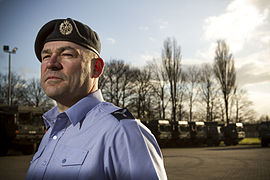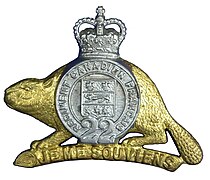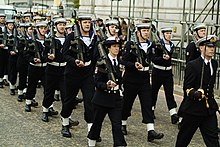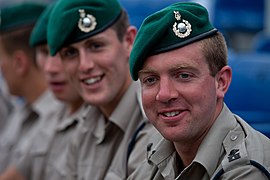Officer Cadet is a rank held by military cadets during their training to become commissioned officers. In the United Kingdom, the rank is also used by members of University Royal Naval Units, University Officer Training Corps and University Air Squadron; however, these are not trainee officers with many not choosing a career in the armed forces.
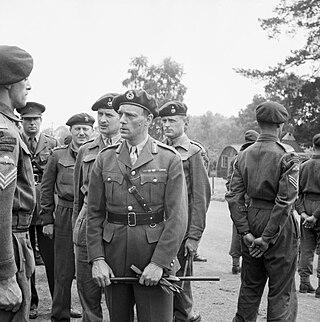
The green beret was the official headdress of the British Commandos, a special-forces unit active during World War II. It is still worn by members of the Royal Marines after passing the Commando Course, and personnel from other units of the Royal Navy, Army and RAF who serve within 3 Commando Brigade and who have passed the All Arms Commando Course.

Mess dress uniform is the most formal type of evening-wear uniform used by military personnel, police personnel, and other uniformed services members. It frequently consists of a mess jacket, trousers, white dress shirt and a black bow tie, along with orders and medals insignia. Design may depend on regiment or service branch, e.g. army, navy, air force, marines, etc. In modern Western dress codes, mess dress uniform is the supplementary alternative equivalent to the civilian black tie for evening wear. Mess dress uniforms are typically less formal than full dress uniform, but more formal than service dress uniform.
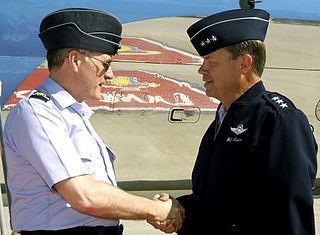
A side cap is a military cap that can be folded flat when not being worn. It is also known as a garrison cap or flight cap in the United States, wedge cap in Canada, or field service cap in the United Kingdom; or in vulgar slang as a cunt cap. In form the side cap is comparable to the glengarry, a folding version of the Scottish military bonnet. It has been associated with various military forces since the middle of the 19th century, as well as various civilian organizations.

A peaked cap, peaked hat, service cap, barracks cover, or combination cap is a form of headgear worn by the armed forces of many nations, as well as many uniformed civilian organisations such as law enforcement agencies and fire departments. It derives its name from its short visor, or peak, which was historically made of polished leather but increasingly is made of a cheaper synthetic substitute.
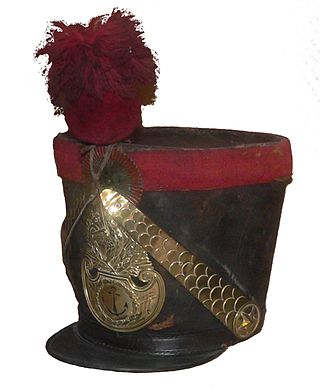
A shako is a tall, cylindrical military cap, usually with a visor, and sometimes tapered at the top. It is usually adorned with an ornamental plate or badge on the front, metallic or otherwise; and often has a feather, hackle, or pompom attached at the top.

The black beret is a colour of beret, a type of headgear. It is commonly worn by paramilitaries and militaries around the world, particularly armored forces such as the British Army's Royal Tank Regiment (RTR), the Royal Canadian Armoured Corps (RCAC), and Royal Australian Armoured Corps (RAAC) and the Indian Army Armoured Corps and Indian Border Security Force. Notable non-armored military units to wear the black beret include the non-military police and non-special forces elements of the Irish Defence Forces, MOD Guard Service, Russian Naval Infantry and Russian OMON units, the United States Air Force (USAF) Tactical Air Control Party (TACP), Philippine National Police-Special Action Force (PNP-SAF) members, and the Royal Canadian Navy. It was also worn by the United Kingdom's Royal Observer Corps (ROC) with their Royal Air Force (RAF) uniform, Metropolitan Manila Development Authority (MMDA).
Forage cap is the designation given to various types of military undress, fatigue or working headwear. These vary widely in form, according to country or period. The coloured peaked cap worn by the modern British Army for parade and other dress occasions is still officially designated as a forage cap.

Full dress uniform, also known as a ceremonial dress uniform or parade dress uniform, is the most formal type of uniforms used by military, police, fire and other public uniformed services for official parades, ceremonies, and receptions, including private ones such as marriages and funerals. Full dress uniforms typically include full-size orders and medals insignia. Styles tend to originate from 19th century uniforms, although the 20th century saw the adoption of mess dress-styled full-dress uniforms. Designs may depend on regiment or service branch. In Western dress codes, full dress uniform is a permitted supplementary alternative equivalent to the civilian white tie for evening wear or morning dress for day wear – sometimes collectively called full dress – although military uniforms are the same for day and evening wear. As such, full dress uniform is the most formal uniform, followed by the mess dress uniform.

The Irish Defence Forces Cap Badge is common to all services and corps of the Irish Defence Forces. Although principally associated with the Irish Army it is also worn by and appears in elements of the insignia of the Naval Service and Air Corps.
The uniforms of the Canadian Armed Forces are the official dress worn by members of Canada's military while on duty.

The uniforms of the British Army currently exist in twelve categories ranging from ceremonial uniforms to combat dress. Uniforms in the British Army are specific to the regiment to which a soldier belongs. Full dress presents the most differentiation between units, and there are fewer regimental distinctions between ceremonial dress, service dress, barrack dress and combat dress, though a level of regimental distinction runs throughout.

These are the official Royal Navy Officer ranks ordered by rank. These ranks are part of the NATO/United Kingdom ranks, including modern and past. Past insignia is in italic.

The modern Irish Army uniform is based on the layer principle, and is designed to provide soldiers in the Irish Army with the right degree of protection for any operational environment.

The maroon beret in a military configuration has been an international symbol of airborne forces since the Second World War. It was first officially introduced by the British Army in 1942, at the direction of Major-General Frederick "Boy" Browning, commander of the British 1st Airborne Division. It was first worn by the Parachute Regiment in action in North Africa during November 1942.

The Royal Air Force uniform is the standardised military dress worn by members of the Royal Air Force. The predominant colours of Royal Air Force uniforms are blue-grey and Wedgwood blue. Many Commonwealth air forces' uniforms are also based on the RAF pattern, but with nationality shoulder flashes. The Royal Air Force Air Cadets wear similar uniforms.
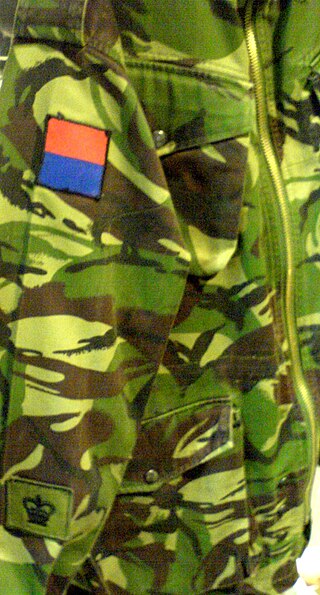
Tactical recognition flash (TRF) is the British military term for a coloured patch worn on the right arm of combat clothing by members of the British Army, Royal Navy and Royal Air Force. A TRF serves to quickly identify the regiment or corps of the wearer, in the absence of a cap badge. It is similar to, but distinct from, the DZ Flashes worn by members of Airborne Forces.

Troops began wearing berets as a part of the headgear of military uniforms in some European countries during the 19th century; since the mid-20th century, they have become a component of the uniforms of many armed forces throughout the world. Military berets are usually pushed to the right to free the shoulder that bears the rifle on most soldiers, but the armies of some countries, mostly within Europe, South America, and Asia, have influenced the push to the left.
This article describes the use of the beret as part of the uniform of various organizations. The use of the beret as military headgear is covered in a dedicated article, Military beret.

The Royal Marines uniform is the standardised military dress worn by members of the Royal Marines.





